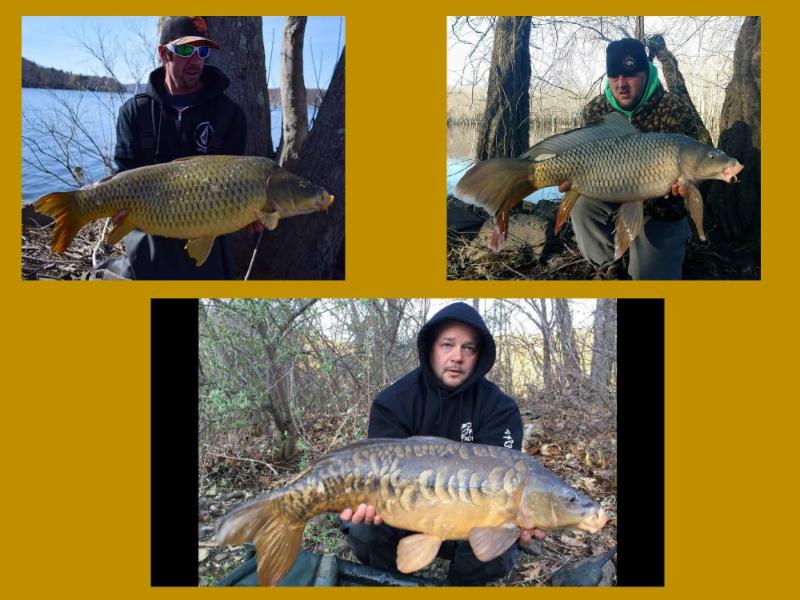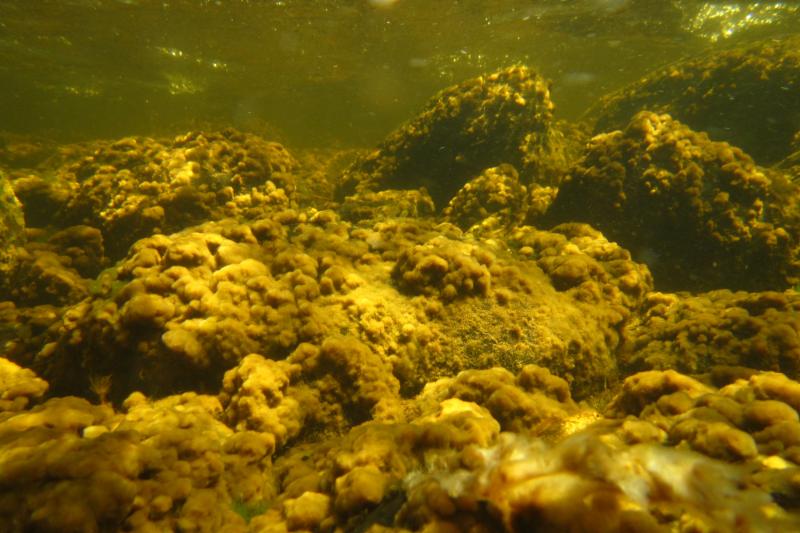|
E-Tackle Box
(links to fishing info)
| |
|
|
|
|
Mystery Fish
|
|
 Do you recognize this fish?
Email your guess to DEEP.inland.fisheries@ct.gov
The April mystery fish was a Brook Trout (Salvelinus fontinalis). Brook Trout are one of Connecticut's two native salmonids. Can you name the other?
A.K.A brookie, native, speckled trout, and salter, this colorful fish has mesmerized anglers for over 200 years.
Nearly driven completely out of Connecticut's waters in the late 1700's due to damming and decreasing water quality and over fishing, Connecticut now has many locations with self-sustaining wild populations (check out our Class One Wild Trout Management Areas).
Brook Trout require year-round cold water temperatures and clean, silt-free gravel to spawn; conditions often found in many of our small headwater brooks and streams.
Moving forward, Brook Trout face new threats with loss of habitat to development and increasing water temperatures.
Collaborative efforts between academic institutions, fishing groups, state agencies, environmental groups, and members of the public are focused on keeping Brook Trout populations healthy and abundant for future generations. |
|
|
|
License Fees Fund Fishing and Hunting Programs
| |
|
100% of the fees collected from the sale of fishing and hunting licenses, tags, permits, and stamps goes to support fish and wildlife conservation, preservation, and recreation programs administered by the Bureau of Natural Resources.
Each time you purchase a license your contribution goes to support fishing, hunting, and open space right here in CT.
So the next time you catch a Walleye, Brown Trout, or Striped Bass, see a Bald Eagle, harvest a white-tail, pheasant, or turkey, give yourself and your fellow sportsmen a pat on the back!
You are making a difference and we thank you for your support!
|
|
|
|
150 Years of Natural Resource Conservation in Connecticut
| |
Visit our special web page frequently throughout 2016 for new features and information related to 150 years of natural resource conservation in Connecticut. |
|
|
|
Are you 16-17 years old?
Get 50% off fishing and hunting licenses
|
All 16 and 17 year old Connecticut residents can purchase 2016 fishing and hunting licenses, tags, permits, and/or stamps at 50% of the full resident cost. Get your license now!.
|
|
|
|
Have a Tip or Photo You Would Like to See in CT Fishin' Tips?
| |
Email your tip to DEEP.Inland.Fisheries@ct.gov
|
|
|
|
Budding Angler in Your Family?
| |
|
|
|
|
Wondering what's new in fisheries?
| |
Get the latest in fisheries through our quarterly reports.
or
|
|
|
|
Connecticut Wildlife Magazine
| |
|
Every issue of this bi-monthly publication includes great wildlife photography, in-depth feature articles written by DEEP biologists, information about hunting and fishing, and natural history articles.
Connecticut Wildlife Magazine is published six times each year.
Subscriptions are $8 for one year, $15 for two, or $20 for three years.
|
|
|
|
Report a Violation
|
Help to protect our natural resources for future outdoor sports enthusiasts. Report suspected violations by calling DEEP Environmental Conservation Police at 1-800-842-HELP
|
|
|
|
Missed an Issue of CT Fishin' Tips?
| |
|
|
|
|
 |
|
FREE FISHING DAY 2016:
This Saturday (May 7) will be Connecticut's annual Free Fishing Day. On May 7, 2016 a fishing license is NOT required to fish inland or marine waters of Connecticut. All other rules including minimum size, daily limits, and those specific to a waterbody remain in effect. Please refer to our Angler's Guide if you have any questions.
We encourage you to take this opportunity and share your passion for fishing with friends and family - for FREE!
2017 Angler's Guide Photo Contest: Be sure to keep your cell phone, Go-Pro, or camera handy! We have begun accepting your best fishing photos for next year's cover. Get all of the details on our web page and email your submissions to deep.inland.fisheries@ct.gov (subject: Angler's Guide Cover Contest). Good Luck!
|
| Family Fishing Day - 2016 |

Come Fish With Us- FREE!
Saturday, May 7, 2016: The No Child Left InsideŽ Great Park Pursuit and CARE program will host our annual "Family Fishing Day" at Stratton Brook State Park, Simsbury from 9:00 am to 3:00 pm. Lots of fun activities for the entire family! No pre-registration is required. See you there!
|

2016 Save the Dates!
Fishing events you and your family will not want to miss.
Saturday, May 21, 2016: World Fish Migration Day
Rainbow Fishway Open House from 10:00 am to 3:00 pm. Come see how migrating fish can climb over the Rainbow Dam on the Farmington River, Windsor, CT. For questions please contact: Bruce.williams@ct.gov GPS: 400 Rainbow Rd. Windsor, CT 06095
Sunday, June 19, 2016: First Free Fishing License Day of 2016! You must obtain a FREE 1-day license which will be available starting 3 weeks prior to the event on the DEEP online licensing system.
Saturday, June 25, 2016: Women Can fish Too! On this day, our basics of fishing class will be open to women only (16 and up). Come to our class, held at the CARE education center in Killingworth (10 am to 3 pm), to get a leg up on your significant other - and show them you can fish too! Call 860-663-1656 to reserve your place (FREE!).
Saturday, August 13, 2016: Second Free Fishing License Day of 2016! You must obtain a FREE 1-day license which will be available starting 3 weeks prior to the event on the DEEP online licensing system. The CARE program will host a saltwater fishing event and atFort Trumbull State Park, New London from 10:00 am to 3:00 pm.
|
 The Bonus Striped Bass Program will run from May 1 through December 31 in 2016.
DEEP will distribute TWO Harvest Tags and Harvest Report Cards per license holder this year.
Tags are now available at specific DEEP Offices and Facilities. There is a limit of TWO TAGS annually per Connecticut fishing license holder. However, for convenience, one person may pick up at most FOUR tags by presenting valid Connecticut fishing licenses for two anglers. Children are also eligible to receive tags by signing up for a free Youth Fishing Passport. Tags will be available on a first come first serve basis for as long as supplies last.
|
| Daily TROUT Stocking Posts |
Daily trout stocking reports are posted on the CT FishandWildlife Facebook page. Watch between 2 pm and 5 pm each day to see a list of waterbodies freshly stocked! A list of fish stocking to date is also posted on our web page.
|

WORLD FISH MIGRATION DAY- MAY 21, 2016. This is an international celebration of migratory fish. The partners who work together to restore runs of migratory fish are planning various activities throughout the region.
We will have open houses at the following fishways: Greeneville Fishlift (Norwich), Rainbow Fishway (Windsor), Haakonsen Fishway (Wallingford), Mianus Pond Fishway (Greenwich).
Staff will be on hand to show the fishway and explain how they work and help migratory fish. There are viewing windows at Greeneville, Rainbow, and Holyoke where you can see migratory fish swim past. Hours are generally 10 am until 3:30 pm.
In addition, the Holyoke Dam Fishlift (Holyoke, MA) will also be having talks and tours. For more information about the Holyoke tour, to RSVP, or get directions email eryba@ctriver.org or call 413-772-2020.
New for this year will be a mass paddling event on the Lower Connecticut River where many of us will gather in kayaks and canoes and paddle up the river with signs, led by restoration specialists, biologists, and engineers. Check out the Connecticut River World Fish Migration Floatilla.
|
|
Looking Back - 150 Years of Natural Resource Conservation
|

Fish Passage - Early colonists tapped into flowing waters to generate power for industry and manufacturing. Unfortunately, there was an immediate impact on migratory fish species. The Fish Commission (established in 1866) recognized the negative impact these dams had upon Atlantic Salmon and American Shad runs and worked quickly to pass legislation (1870) requiring all future dams to have fish passage.
Early attempts to restore fish passage included fishways significant dams on the Connecticut, Shetucket, and Housatonic Rivers (like the photo above from Turners Falls, crica 1897). Unfortunately, due to a variety of issues, these fishways did not pass significant numbers of fish.
The Diadromous Fisheries Restoration program led by Steve Gephard continues to work collaboratively with a variety of partners to increase fish passage wherever barriers exist.
We hope you will join us at the Rainbow Reservoir Fishway on World Fish Migration Day (details above) to help celebrate past fish passage successes and continue supporting this work into the future.
|
 Common Carp fishing is HOT! With Connecticut's largest freshwater fish moving into the shallows to spawn, May is a great time to get out and try to catch one of these monster fish. Common Carp (Cyprinus carpio) were introduced by the United States Fish Commission in 1871 to develop a consistent and reliable source of protein for the rapidly expanding country.
Since that time, the Common Carp, not to be confused with other highly problematic Asian Carp species, have become established in many lakes, ponds, and large rivers. We encourage you to learn about this great fishery right in your back yard. |
 Trout fishing is at peak! As we approach the middle of May, almost 80% of our catchable-sized trout will have been stocked into over 200 rivers and streams and 100 lakes and ponds. This May, the cooler than normal weather is contributing to maintaining excellent trout fishing conditions for several weeks to come. Fish ON! |
 Rock Snot: Rock Snot is commonly used to refer to a group of diatoms (single cell microscopic algae), which under certain environmental conditions grow prolifically (bloom), forming thick mats that can cover large sections of the river bottom. The majority of these species belong to the genera Didymosphenia or Cymbella.
Rock Snot can survive for several weeks or months with only slightly moist conditions. As such, it is fairly easy for anglers to accidentally introduce living cells from one water to another. The most effective way to reduce the potential for transferring rock snot to other waters is to practice Check, Clean, Dry. CHECK: Before leaving the water, remove all obvious clumps of algae and plant material from fishing gear, waders, clothing and footwear, canoes and kayaks and anything else that has been in the water. Leave them at the site. If you find any later, clean your gear and dispose of all material in the trash.
CLEAN: Soak/spray and scrub boats and all other "hard" items for at least one minute in either very hot (140°F) water, a 2% bleach solution, or a 5% dishwashing detergent solution. A 20% salt solution for 30 seconds has also been shown to be effective. Absorbent materials such as clothes and felt soles on waders should be soaked for at least 40 minutes in very hot water (140°F), or 30 minutes in hot water (115°F) with 5% dishwashing detergent. Freezing will also kill the cells.
DRY: Drying will also kill the cells, but items must remain completely dry (inside and out) for at least 48 hours.
When outdoors, use only small quantities of cleaning agents such as bleach, dishwashing detergent, and other chemical compounds. Always avoid using cleaning agents streamside or in areas where they can drain into surface waters. When possible, clean all gear, boots, boats and clothing at home.
|
 By purchasing a fishing license, you help to support conservation and improvement of Connecticut's fisheries. Thank you! By purchasing a fishing license, you help to support conservation and improvement of Connecticut's fisheries. Thank you! |
|
|